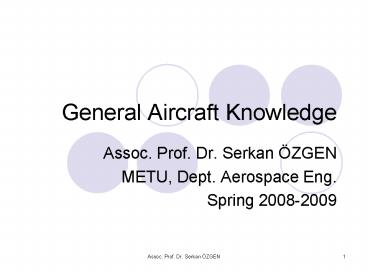General Aircraft Knowledge - PowerPoint PPT Presentation
1 / 30
Title:
General Aircraft Knowledge
Description:
Fuselage, wings, tailplane, fin. Primary flight controls. ... Tailplane and fin. The tail is generally similar to the wings and consists of a vertical and ... – PowerPoint PPT presentation
Number of Views:2202
Avg rating:3.0/5.0
Title: General Aircraft Knowledge
1
General Aircraft Knowledge
- Assoc. Prof. Dr. Serkan ÖZGEN
- METU, Dept. Aerospace Eng.
- Spring 2008-2009
2
Outline
- Fuselage, wings, tailplane, fin.
- Primary flight controls.
- Landing gear.
- Flight instruments.
3
Fuselage
- Fuselage forms the body of an airplane to which
the wings, tail, engine and landing gear are
attached. - The fuselage of many modern airplanes is of
semi-monocoque construction, a light framework
covered by skin. - The internal framework carries almost all of the
stress (load), while the skin, which is like an
egg shell carries the remaining stress.
4
Fuselage
5
Wings
- The wings designed to generate lift and are
exposed to high loads that can exceed the total
weight of the airplane during maneuvers. - Wings generally have one or more spars attached
to the fuselage and extending to the wingtips.
They carry major loads. They bend upward when
there is lift and downward when the airplane is
on ground. - Some wings have struts.
6
Wings with struts
7
Wings
- Ribs are roughly perpendicular to the spars. They
provide the airfoil shape and stiffen the skin
attched to them. The ribs transmit loads between
the skin and spars. - Ailerons are fitted at the outer trailing edge of
each wing and move in opposite directions to
control roll. - Flaps are fitted on the inner trailing edges and
are lowered to increase the lift and drag so that
an unaccelerated, steep descent could be
maintained during landing. - Wings may also contain fuel tanks.
8
Wings
9
Tailplane and fin
- The tail is generally similar to the wings and
consists of a vertical and horizontal stabilizer
to which the rudder and the elevator are
attached. - The elevator and on some airplanes the rudder
will have trim tabs.
10
Primary flying controls
- Each of the three primary control surfaces moves
the airplane about one of the three axes of
flight. - The ailerons bank or roll the airplane about its
longitudinal axis. - The rudder yaws the airplane about its vertical
axis. - The elevator moves the airplane about its lateral
axis changing the airplanes pitch attittude.
11
Primary flying controls
12
Primary flying controls
13
Primary flying controls
14
Primary flying controls
15
Primary flying controls
16
Primary flying controls
17
Primary flying controls
18
Landing gear
- The landing gear (or undercarriage) supports the
weight of the airplane when it is on the ground. - May be a tricycle type with a nosegear or a
tailwheel type. - Most tricycle landing gears have nosewheel
steering through rudder pedals and almost all
airplanes have main gear brakes. - Advanced airplanes have retractable landing gear,
while some other have fixed landing gear.
19
Landing gear - tailwheel
20
Landing gear - tricycle
21
Landing gear - retractable
22
Flight instruments
- The altimeter indicates the height of the
airplane from the sea-level or a determined
reference altitude.
23
Flight instruments
- The airspeed indicator indicates the speed at
which an airplane moves through air in knots
(nm/h, 1 knot 1.8532 km/h).
24
Flight instruments
- The vertical speed indicator displays the rate at
which the airplane is climbing or descending in
100ft/min.
25
Flight instruments
- The gyro-compass or the bearing indicator
displays the direction at which the airplane is
flying.
26
Flight instruments
- The artificial horizon displays the attitude of
an airplane with respect to the horizon.
27
Flight instruments
- The turn and slip indicator indicates whether an
airplane is performing a coordinated turn, i.e.
it is not skidding out of the turn or not
slipping into the turn.
28
Flight instruments
29
Flight instruments
30
(No Transcript)































